|
 |
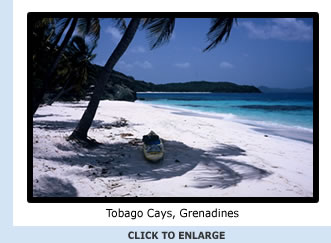 The Grenadines are strung like dewdrops on a strand of silk between
the volcanic frontier island of St. Vincent and the tourist Mecca
of Grenada in the southeast Caribbean. Like most Caribbean islands,
the Grenadines both divide and unite the Atlantic Ocean and the Caribbean
Sea. This cozying up of oceans is seldom peaceful: Inter island channels
become rivers at change of tide when water pours between the two
oceans at speeds of up to four knots. In the summer, the Grenadines
entertain powerful tropical storms and hurricanes from both oceans.
In winter, gales from the North Atlantic whip the Caribbean to a
frothy greenish-white in the Grenadines.
The Grenadines are strung like dewdrops on a strand of silk between
the volcanic frontier island of St. Vincent and the tourist Mecca
of Grenada in the southeast Caribbean. Like most Caribbean islands,
the Grenadines both divide and unite the Atlantic Ocean and the Caribbean
Sea. This cozying up of oceans is seldom peaceful: Inter island channels
become rivers at change of tide when water pours between the two
oceans at speeds of up to four knots. In the summer, the Grenadines
entertain powerful tropical storms and hurricanes from both oceans.
In winter, gales from the North Atlantic whip the Caribbean to a
frothy greenish-white in the Grenadines.
Touring the Grenadines on a paddleboard should not be taken lightly.
You must prepare mentally and physically to function optimally in
foreign cultures. You should be comfortable with paddling long distances
in the open sea. You will paddle with your board fully loaded with
gear in four to six foot swells and fifteen to twenty knot winds.
Good charts, GPS, VHF radio and cell phone are essential. Carry plenty
of food and water. Protect yourself from the sun. The ocean is warm
but take a neoprene vest.
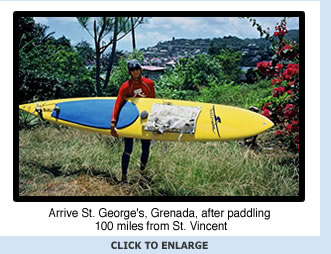 It is a trial to ship your paddleboard to the Grenadines. The Bernuth
Agency in St. Vincent sometimes ships between St. Vincent and Miami.
Check with Customs and Immigration on St. Vincent to find a current
inter island shipper. Be sure your board is well padded in its crate.
It is a trial to ship your paddleboard to the Grenadines. The Bernuth
Agency in St. Vincent sometimes ships between St. Vincent and Miami.
Check with Customs and Immigration on St. Vincent to find a current
inter island shipper. Be sure your board is well padded in its crate.
Plan to paddle in the Grenadines in the fall
or the spring. The months of September and October come before
the strong northeast winds of winter dominate the Grenadines. April
and May can offer calm weather before summer’s powerful southeast
trade winds take over. Weather patterns can be fickle. Northeast
winds can blow in summer; southeast winds happen in winter.
If you decide to paddle south from St. Vincent to Grenada, as I
did, start paddling from Blue Lagoon on the south tip of St. Vincent.
The nine-mile Bequia channel is tough. Current flows east or west
at two to three knots and can move against the wind. Waves will knock
you off your paddleboard. Attach yourself to your board with a leash.
When you reach Admiralty Bay on Bequia’s west coast, you can
stay a day and explore the island from the sanctuary of a cheap guesthouse.
Bequia is a melting pot. You will see black faces with green eyes,
pale skin and freckles above the full lips of Africa. Boat building
thrives on Bequia. Everywhere are brightly painted handmade wooden
sailing dinghies with names like Brave Heart or Hold ‘em Down:
odes to Bequia’s love of ocean racing. Bequia reveres confrontation
with the sea. However odd you are, if you contain salt water, you
will be loved.
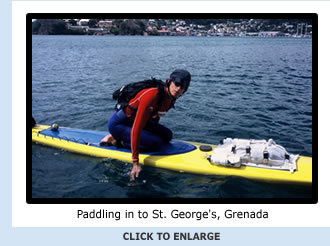 > Your next destination, nine miles east of
Bequia, is Mustique: a celebrity hot spot. The sea between Bequia
and Mustique is not as rough as the Bequia channel, but watch your
drift north or south. Aim for the notch in Mustique’s hilltop. As you stroke into
Brittania Bay, Mustique’s harbor, you may see Mick Jagger enroute
to his getaway, or Prince Charles getting ready for a little R & R.
Mustique has attitude and nowhere cheap to stay. But island fishermen
are basic and honest. Fishermen, who live in fishing camps on most
Grenadines islands, are good meteorologists. Consult them about local
conditions before paddling. > Your next destination, nine miles east of
Bequia, is Mustique: a celebrity hot spot. The sea between Bequia
and Mustique is not as rough as the Bequia channel, but watch your
drift north or south. Aim for the notch in Mustique’s hilltop. As you stroke into
Brittania Bay, Mustique’s harbor, you may see Mick Jagger enroute
to his getaway, or Prince Charles getting ready for a little R & R.
Mustique has attitude and nowhere cheap to stay. But island fishermen
are basic and honest. Fishermen, who live in fishing camps on most
Grenadines islands, are good meteorologists. Consult them about local
conditions before paddling.
The fifteen-mile Canouan channel is brutal. Do not attempt it in
winds over fifteen knots. Depending on wind and tide, current flows
north or south at two to three knots. Ask fishermen when the southbound
current flows. You cannot paddle from Mustique to Canouan on a northbound
current. Aim for a small, triangular island visible from the south
tip of Mustique called Petit Canouan; it is only four miles from
Canouan. In the lee of Petit Canouan, you might find, as I did, an
old fisherman in his red-and-green boat. He will be angry with you
for ruining his fishing.
Be careful of gusty winds and steep waves
off the north end of Canouan. Head for the middle of Canouan’s west coast, where you will
find a settlement. Canouan is an uneasy place. Europeans have built
resort hotels above Canouan’s main attraction, a limpid, turquoise
lagoon whose boundary reef fends off the unruly open sea. Rich tourists
stay in the hotels and snorkel in the lagoon, but they don’t
spend money on local business. In comparison to the hotel scene,
Canouanians feel poor and insignificant. Visitors to Canouan, like
you on your paddleboard, are lumped in with the hotel crowd and disliked.
You can stay on Canouan more cheaply than in a resort hotel but don’t
expect to feel welcome.
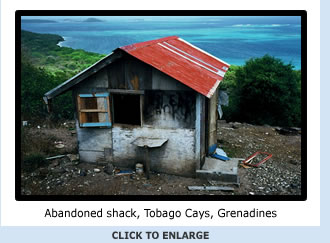
Next stop south is Mayreau, which is paradise. Dreadlocked locals
grin at you and offer cheap lodging. Beer flows day and night on
Mayreau and the tasty food is cheap. The little island, whose center
rises in a comforting, blond and grassy mound toward a blue vault
of sky, offers spectacular views of where you paddled from: Canouan,
Mustique, Bequia. You can also inspect your next nearby paddling
goals: Union island, Petit St. Vincent, Petit Martinique, Carriacou,
and the Tabago Cays.
Leaving new friends on Mayreau is hard, but
the Tobago Cays welcome you and invite you to stay forever. Vendors
from Union Island, just two miles away, buzz over in their boats
and sell food and beer to castaways who, like you, can’t bear to leave the beauty of
the Tobago Cays: A dozen gleaming islets bask in clear, shallow water
guarded from the deep sea by an outer reef. If the Grenadines are
the Caribbean’s crown jewels, the waters of the Tobago Cays
are its emeralds and sapphires. Though powder soft, the beaches are
diamonds. Live forever on a Tobago Cay.
Eventually, you go on to Union Island, just
two miles southwest of the Tobago Cays. Union is the Grendines’ bad boy. Tilted
at odd angles, Union’s sharp little mountains lean toward one
another as if sharing evil gossip. The shallow reef in front of Union’s
town has a shady history: Locals wait for yachts to run aground on
the reef, then rush out in motor boats and offer to tow the yacht
free. The good Samaritans instantly turn into pirates and plunder
the yacht. Your paddleboard is not a yacht, but look out.
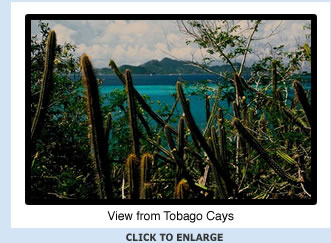 Union Island in on the border between two
Caribbean countries, St. Vincent and the Grenadines and Grenada.
If you plan to paddle Grenada waters, you must legally clear your “vessel” out
of St Vincent and the Grenadines at the Customs and Immigration
Office on Union Island. Failure to do this may result in a stiff
fine or confiscation of your paddleboard. I kid you not. Union Island in on the border between two
Caribbean countries, St. Vincent and the Grenadines and Grenada.
If you plan to paddle Grenada waters, you must legally clear your “vessel” out
of St Vincent and the Grenadines at the Customs and Immigration
Office on Union Island. Failure to do this may result in a stiff
fine or confiscation of your paddleboard. I kid you not.
Visit Petit St. Vincent, west of Union and
the last Grenadine in the island chain. Owned by an entrepreneur
who saw the island’s
potential in tourist revenue, PSV is a small, exclusive resort. The
beaches are pure, coral reefs unspoiled. The contrast between turquoise
and emerald shallows and the cobalt and cream deep sea (so like the
interplay of soft and grand chords in a skilled orchestra) touches
the heart. But PSV is a prison for the rich. No matter how nice the
view from a cell window, a prison is a prison, and a prisoner a prisoner.
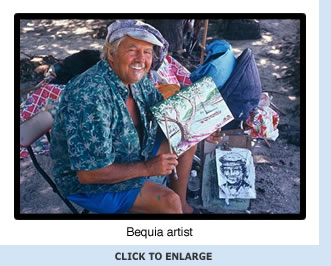 Petite Martiniqu is the antidote to PSV and
two miles away. Petite Martinique belongs to Grenada. Reggae music
seeps even from its grains of sand. Dilapidated buildings welcome
you like comfortable old armchairs. Dark, half naked children crowd
the beach and ask you for paddleboard rides. You can stay cheaply
anywhere. As good as PM’s aloha
spirit, is the view from its mango infested little mountain: You
will see the end of your journey: The sloping flank of Grenada looms
ghostly gray in the distance. Petite Martiniqu is the antidote to PSV and
two miles away. Petite Martinique belongs to Grenada. Reggae music
seeps even from its grains of sand. Dilapidated buildings welcome
you like comfortable old armchairs. Dark, half naked children crowd
the beach and ask you for paddleboard rides. You can stay cheaply
anywhere. As good as PM’s aloha
spirit, is the view from its mango infested little mountain: You
will see the end of your journey: The sloping flank of Grenada looms
ghostly gray in the distance.
You must clear your “vessel” in to Grenada when you
reach Carriacou, PM’s southern neighbor. Carriacou belongs
to Grenada, where Immigration is strict. Carriacou is an embattled
island. Once a stronghold for the ingenuous and welcoming heart of
those who subsist on nature’s bounty. Carriacou reluctantly
modernizes. Locals still fish, bake bread and eat the animals they
care for, but the tourist dollar says, “There’s something
better.” Locals yearn to move forward, but the old life still
appeals. Carriacou looks to its roots yet already uproots into its
future. You will be bruised by the island’s beauty and its
struggle.
Grenada… your tour de force.
The twenty-mile paddle from Carriacou to Grenada is demanding.
If you struggled with wind and current in other channels, you will
balance on the tightrope of feasibility as you negotiate the channel
between Carriacou and Grenada. The strong, predominantly east wind
and an east bound current invite you to fall forever into the mighty
fetch of the Caribbean that stretches west to Central America.
Kick-‘em-Jenny, an
underwater volcano lurks in the waters between Carriacou and Grenada.
If you don’t get boiled in Kick ‘em’s superheated
water, aim for Sauteurs, Grenada’s north most town. The flash
of sunlight from Sauteurs’s windows will beckon you on.
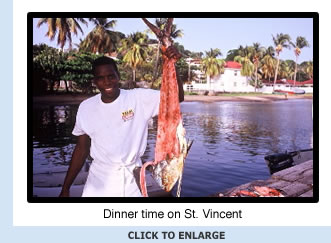 When you reach Sauteurs, you may feel that
the pain of your journey has been too much. Remember the people
who gave Sauteurs its name (Sauteurs means “jumpers” in
French.) Threatened with banishment from their loved native island,
hundreds of Carib Indians jumped to their death from a high cliff
near Sauteurs. Whatever burden you bear will probably be less than
that of the jumpers. When you reach Sauteurs, you may feel that
the pain of your journey has been too much. Remember the people
who gave Sauteurs its name (Sauteurs means “jumpers” in
French.) Threatened with banishment from their loved native island,
hundreds of Carib Indians jumped to their death from a high cliff
near Sauteurs. Whatever burden you bear will probably be less than
that of the jumpers.
If you paddle, like me, the west coast of
Grenada to its capital, St. Georges, you will find Grenadians friendly
and aware. If you talk politics, you risk embarassment. Grenadians
know more about your country than you. They know everything about
their island and as much as there is to know about the rest of
the world. Grenadians know instantly when an unusual stranger reaches
their island. If you paddle in to a town to eat or spend the night,
they will say, “I
heard all about you.” Grenadians offer warmth and hospitality
without restriction to all visitors. By the time you leave Grenada,
it will know you better than you know yourself.
|
 |
